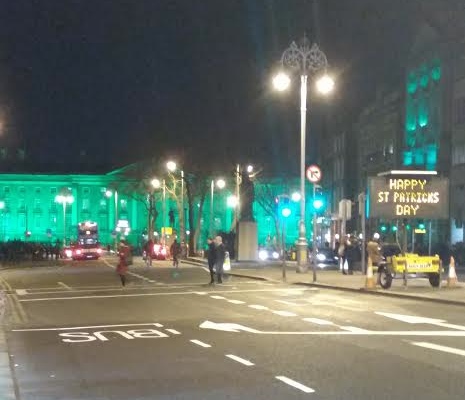St. Patrick’s Day in Ireland. Bound to be crazy, right?
First, semantics: I wrote out “Patrick,” instead of abbreviating to “Patty,” as we commonly do in America. In the run-up to the holiday, I read some passionate arguments pointing out that “Patty” is an Anglicized nickname; it means nothing in Irish. Therefore, you should use the full “St. Patrick’s Day”. That left me confused, however, since the name “Patrick” itself is the English version of the Irish “Padraig” (which would appropriately be nicknamed “Paddy”). So, shouldn’t we call it St. Padraig’s Day? Apparently the Irish are OK with Patrick, but “Patty” is just one step too far.
In the weeks leading up to St. Patrick’s Day, Dublin began decking itself out. Shops sold all kinds of green hats, scarves, headbands, etc so that everyone would be ready on the big day. There has been construction in the city center for months, but they had to have it finished by March 17th so the parade could go through. I was in the city center the night before, and lots of monuments were lit up with green lights, and traffic signs were bidding everyone a Happy St. Patrick’s Day in both English and Irish.

On the day itself, a friend and I walked into town two hours before the parade was due to start, and people bedecked in green were already lining the route. We managed to find a place where we could at least see a little bit and then settled in to wait two long hours. It was a fairly nice day, but still chilly, and when you’re standing in one spot outside for that long it’s absolutely freezing.

As much as I hate to say this, I wasn’t too impressed with the parade. The theme was “Imagine if” (nice and vague), and various organizations hosted floats that were supposed to be related to the theme. On the plus side, they were incredibly creative. So creative, in fact, that they passed into the realm of bizarre and were completely incomprehensible. For example, one float was a huge mouth, with people holding other facial features dancing around it. Many of them seemed to be based on full stories but were hard to grasp in the context of a parade.

Of course, there were also the requisite horses (with a guy walking along behind with a huge portable vacuum cleaner type thing vacuuming up horse poo. He got the biggest cheers of anybody in the parade!). There were also lots of marching bands, but for some reason most of them were from the U.S. Looking up the program online, I counted 11 from American high schools and colleges, 2 from Ireland, and 1 from France. Why was Dublin’s St. Patrick’s Day parade mostly filled with American musicians?

After the parade, you fight the sea of green-clad people to get to a pub. Get. To. A. Pub. There were also lots of vendors selling food outside of Christ Church Cathedral, and it all smelled delicious, but it’s St. Patrick’s Day. You want to be in a pub. My friend and I went to The Brazen Head, which claims to be Dublin’s oldest pub (although that is disputed by a few others). It was already completely packed, but everyone in the service industry must be so prepped for this day that they were incredibly efficient and we were able to get a table with only a short wait.

After that, we wandered around town watching the poor Garda (police) valiantly trying to enforce the laws against drinking on the street. But they were clearly fighting a losing battle.
As great as it was to spend St. Patrick’s Day in Ireland, I would bet that some American cities actually have bigger festivities and crazier parties than Dublin did. I mean, come on, the Liffey wasn’t even dyed green.
The next event on the list was the 100 year anniversary of the Easter Rising, the rebellion that, although a failure in itself, paved the way for Ireland’s independence a few years later. Although the actual date of the Rising was in April, it fell on Easter that year, so the celebrations were on Easter this year. So, subsequently, no one cared about Easter itself.
The anniversary of the Easter Rising is a huge deal. They’ve been hyping it since January with special city tours, talks, memorials, banners, and souvenirs (I once heard someone remark that you can probably buy 1916 candy bars now, and indeed there are booths on the street selling hats, scarves, t-shirts, flags, and more, all with the date, the names of the leaders of the Rising, or even their pictures).
You could trace the lead up to the Rising pretty much back to the original inhabitants and settlers of Ireland (as a guide for a 1916 walking tour I was on actually did, and because he talked for so long I actually don’t remember much of what he told us, sadly), but the main event was when the Irish Volunteers seized the General Post Office and a few other key sites in Dublin in an attempt to throw off the British rule and establish Ireland as a Republic.
The Rising lasted six days before they were overwhelmed by the British forces. Of course, there were lots of significant events and people of importance, but I’ve been interested in the stories of the women connected with the Easter Rising. At the events commemorating the anniversary today, I heard a quote, which I can’t cite exactly or even remember who it was attributed to, but it was from one of the leaders, and it was to the effect that the movement would be nothing without the inclusion of women.
The most prominent of these women was Countess Markievicz. By all accounts she fought side by side with the men and held a prominent command position. After her surrender, she was sentenced to death, along with the other leaders. However, because she was a woman, her sentence was changed to life imprisonment. Apparently she was quite insulted about being spared solely because of her gender. She was freed in 1917 after a general pardon from London, and she was became the first women elected to the British House of Commons, although she never served.
James Connolly’s assistant, Winifred Carney, was the only women present in the GPO when it was first occupied, and she’s said to have run through the front doors of the building with a typewriter in one hand and a revolver in the other.
When it became clear that the officers in the GPO needed to communicate with those holding positions on the other side of the street, they decided to set up a wire between the two buildings over which they could send messages in tin cans. But, they needed someone to run across the street under sniper fire to string the wire. The only volunteer? A woman.
There was also a female branch of the Irish Volunteers, the paramilitary force involved in the Rising, called Cumann na mBan, and it was one of the members, Elizabeth O’Farrell, who ultimately delivered the official surrender to the British. Winifred Carney and Countess Markievicz were also members.
I’ve picked up these accounts from various places, including a tour of Glasnevin Cemetery and the 1916 walking tour I went on, but I wasn’t able to recall all of the names and I’m sure some of the details slipped my mind as well. Still, these narratives should give you a small glimpse of some of the people involved in the Easter Rising.
So, today, on Easter Sunday, the country celebrated the 100 year anniversary of these remarkable, inspirational, and tragic events. Government officials were escorted from Dublin Castle to the General Post Office where they were given military honors, a prayer was said, children from the four counties laid flowers, bands and pipers played, and the Air Corps did a flyby.

The most significant event was when the Proclamation of the Republic, which Patrick Pearse originally read outside the GPO, was read again in the same place. After all of the solemnity, there was a military parade. I didn’t stay for the whole thing, because it was troops upon troops upon troops and tanks and more tanks and every kind of vehicle that the Irish Army possesses, with running commentary as to their previous and current use and capabilities.
While Easter Sunday marked the official anniversary of the Easter Rising, it will be interesting to see if anything happens in April, on the actual anniversary.

Pingback: Let’s go to Ireland: Tips from the podcast – Going Out Your Door